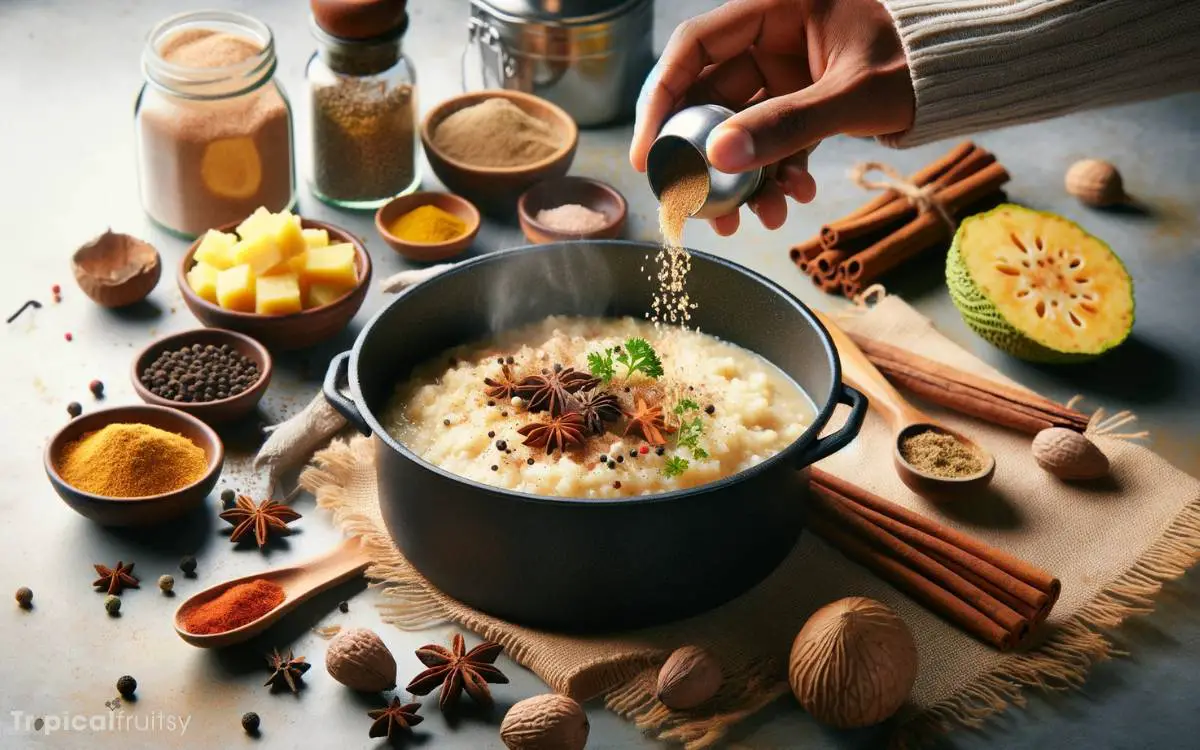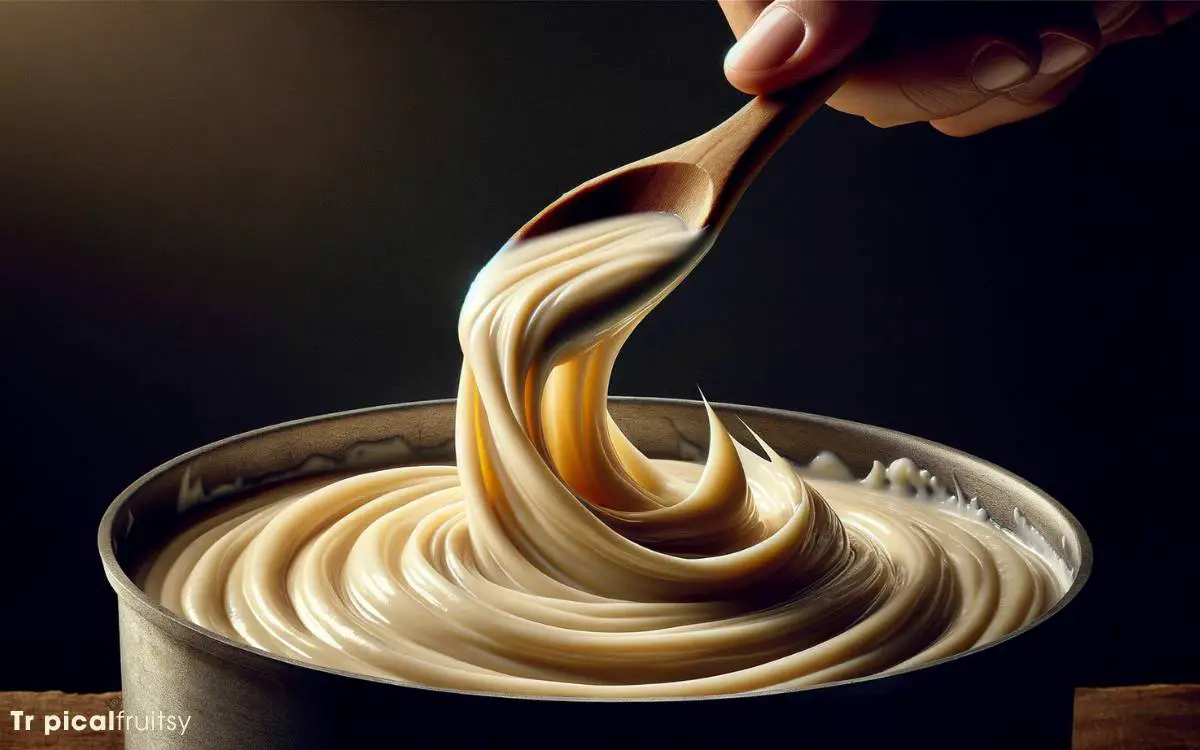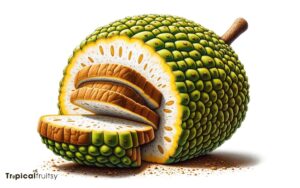How to Cook Breadfruit Porridge? 7 Easy Steps!
Cooking breadfruit porridge is a simple process that results in a delicious and satisfying meal. It involves selecting a ripe breadfruit, peeling and dicing it, then simmering it with milk, spices, and sweeteners until thick and creamy.
This traditional dish can be easily customized and is perfect for a hearty breakfast or a comforting dinner.
Here are some quick steps:
Enjoy a warm bowl of homemade breadfruit porridge, a traditional dish that’s both nourishing and comforting.

Key Takeaway
Gathering Essential Ingredients
To prepare breadfruit porridge, one must assemble a collection of essential ingredients including ripe breadfruit, milk, sugar, spices, and any additional flavorings to enhance the taste.
For a standard batch, precisely 450 grams of peeled and cored breadfruit should be procured. Incorporate 950 milliliters of whole milk for a rich and creamy consistency, though substitutions with almond or coconut milk can be made for dietary preferences.
Sweetness is achieved by adding 50 grams of granulated sugar, adjustable to taste. Aromatic complexity arises from a teaspoon each of ground cinnamon and nutmeg. Optionally, a pinch of salt may be used to balance the flavors.
Vanilla extract, two teaspoons, serves as a common enhancer, contributing a subtle, yet profound depth to the porridge.
Step 1: Selecting the Perfect Breadfruit

Choosing the ideal breadfruit for your porridge begins with identifying a specimen that is ripe yet firm to the touch, ensuring the fruit’s natural sweetness and suitable texture.
Look for a uniform, cream-to-yellow skin tone, indicative of optimal ripeness, and a weight that feels substantial for its size—suggesting a dense, starchy interior.
The surface should yield slightly under pressure, but not be soft or mushy, which can denote overripeness. Aroma is another critical factor; a fragrant, sweet smell emanates from a breadfruit that is ready for culinary use.
Once the appropriate fruit is selected, it should measure approximately 15-20 centimeters in diameter for a standard recipe.
Step 2: Preparing Breadfruit for Cooking

Having selected an appropriate breadfruit, one must now carefully peel and core the fruit before dicing it into small pieces to ensure even cooking.
Employ a sharp knife to excise the peel, minimizing waste while revealing the starchy flesh. The core, being fibrous and inedible, should be meticulously removed.
Subsequent to coring, section the fruit into uniform, bite-sized cubes, approximately 1.5 cm each, to facilitate a consistent textural outcome throughout the porridge.
Precision in cutting not only enhances the porridge’s mouthfeel but also contributes to an optimal release of the breadfruit’s subtle, sweet flavor during the cooking process.
| Step | Tool | Detail |
|---|---|---|
| Peel | Sharp knife | Remove skin cleanly |
| Core | Corer/Cutting implement | Extract inedible center |
| Dice | Chef’s knife | Cut into 1.5cm cubes |
| Inspect | Eye | Ensure uniformity and quality |
Step 3: Cooking Breadfruit Basics

After collecting the necessary ingredients for breadfruit porridge, the next step involves peeling the breadfruit, removing its core, and cutting it into small, even pieces to ensure uniform cooking.
Begin by excising the thick, green skin with a sharp paring knife to reveal the starchy, cream-colored flesh.
Eject the fibrous core and segment the pulp into approximately 2 cm cubes; this size facilitates not only expedited cooking but also a consistency amenable to a smooth, homogenous porridge.
It is critical to maintain a rigorous standard of uniformity in cube dimensions to prevent an uneven texture in your final dish.
The prepared breadfruit is now poised for the culinary process, where it will be softened and amalgamated with the chosen blend of spices and liquids.
Step 4: Adding Flavor and Spices

Enhancing the taste profile of breadfruit porridge can be achieved by incorporating a carefully measured blend of spices.
For a sweet variation, consider adding:
- 1 teaspoon of ground cinnamon
- A pinch of nutmeg
- 2 tablespoons of brown sugar or honey
Conversely, for a savory twist, try adding:
- 1/2 teaspoon of ground turmeric
- 1/2 teaspoon of ground cumin
- A pinch of sea salt
These spices can infuse the dish with a warm, aromatic complexity.
Spice Blend Choices
Selecting the right blend of spices is crucial to elevating the flavors of your breadfruit porridge. The incorporation of a well-balanced spice mix will impart a rich and aromatic profile to this traditional dish.
Here is a table of recommended spices, including their precise measurements and flavor contributions:
| Spice | Measurement | Flavor Profile |
|---|---|---|
| Cinnamon | 1/2 tsp | Warm, sweet undertones |
| Nutmeg | 1/4 tsp | Spicy, nutty notes |
| Allspice | 1/8 tsp | Intense, peppery zest |
| Vanilla Extract | 1 tsp | Sweet, floral essence |
| Ground Ginger | 1/4 tsp | Pungent, sharp warmth |
Incorporate these spices into your porridge to create a complex flavor matrix that complements the starchy nature of breadfruit. Adjust the quantities to suit your palate, ensuring each spice harmonizes without overpowering the others.
Sweet Vs Savory
While breadfruit porridge can be tailored to sweet or savory preferences, the choice of additional flavors and spices plays a pivotal role in defining the dish’s final taste profile.
For a sweet variation, consider incorporating cinnamon or nutmeg at a measurement of one-quarter teaspoon per cup of mashed breadfruit. Vanilla extract, measured at half a teaspoon, can also impart a warm, aromatic essence.
Alternatively, a savory rendition might employ a blend of garlic powder and smoked paprika, each at one-eighth teaspoon per cup, to introduce a depth of flavor.
Fresh herbs like thyme or rosemary, finely chopped to a tablespoon, can add a fragrant dimension. Balancing these elements is key to achieving the desired palate.
Step 5: Achieving the Perfect Consistency

To achieve the perfect consistency for breadfruit porridge, it is essential to carefully balance the ratio of liquid to fruit.
Here are the critical steps to ensure your porridge has the ideal texture:
- Begin with a base of 1 cup of diced breadfruit to 2.5 cups of liquid, typically a combination of water and coconut milk.
- Cook the mixture on low heat, stirring occasionally, to prevent sticking and promote even softening of the breadfruit.
- Adjust the thickness by adding liquid in small increments of 1/4 cup if the porridge is too thick, or continue cooking if too runny.
- Taste frequently, considering that as the starches break down, the porridge naturally thickens upon cooling.
Step 6: Serving Suggestions and Toppings

Upon completion of the breadfruit porridge, consider enhancing its flavor and aesthetic appeal with an array of toppings and accompaniments.
For a balanced fusion of sweetness and texture, sprinkle 30 grams of toasted coconut flakes, adding a delightful crunch and nutty flavor profile.
Introduce 15 milliliters of honey or pure maple syrup to imbue a subtle, natural sweetness that complements the starchy base of the porridge.
To elevate the dish with a hint of spice, a quarter-teaspoon of ground cinnamon or nutmeg can be dusted on top, providing a warm and comforting aroma.
For added richness, a dollop of cream or a swirl of unsweetened almond milk can be incorporated, adjusting to a preferred consistency. With these toppings, the porridge becomes a versatile canvas for flavor experimentation.
Can Overripe Breadfruit be Used to Make Breadfruit Porridge?
Yes, overripe breadfruit can definitely be used to make breadfruit porridge. Simply follow these easy steps for cooking breadfruit: peel and chop the breadfruit, boil in water until soft, then blend into a smooth puree. Add milk, sugar, and spices to taste, and enjoy a delicious and filling porridge.
Step 7: Storing and Reheating Leftovers

Storing leftover breadfruit porridge properly ensures its freshness and quality for future enjoyment.
To maintain the optimal sensory characteristics and prevent spoilage, adhere to the following precise storage guidelines:
- Cooling: Rapidly cool the porridge to a temperature below 40°F (4°C) within two hours of preparation to minimize bacterial growth.
- Airtight Containers: Transfer the porridge into airtight containers to preserve moisture content and prevent the absorption of other flavors from the refrigerator.
- Refrigeration: Store the sealed containers in the refrigerator, where they will remain consumable for up to 3-5 days.
- Reheating: When ready to consume, reheat the porridge to an internal temperature of 165°F (74°C), ensuring a uniform heat distribution to revive its original texture and flavor profile.
Conclusion
The culinary journey of transforming breadfruit into a delectable porridge culminates in a dish that is both nutritious and comforting.
By meticulously selecting ingredients, employing precise cooking techniques, and infusing an array of spices, one ensures the porridge is flavorful and consistent in texture.
When the proof of the pudding is in the eating, this breadfruit porridge stands as a testament to the rich tapestry of flavors achievable through thoughtful preparation and culinary expertise.






